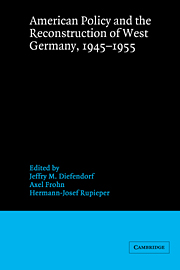Book contents
- Frontmatter
- 1 “Ripping Holes in the Iron Curtain”: The Council on Foreign Relations and Germany, 1945–1950
- 2 U.S. Policy on a West German Constitution, 1947-1949
- 3 American Policy toward German Unification, 1949-1955
- 4 Marshall Plan and Currency Reform
- 5 American Policy toward Germany and the Integration of Europe, 1945-1955
- 6 From Morgenthau Plan to Schuman Plan: America and the Organization of Europe
- 7 Return to Normality: The United States and Ruhr Industry, 1949-1955
- 8 West German Agriculture and the European Recovery Program, 1948-1952
- 9 Science, Technology, and Reparations in Postwar Germany
- 10 American Deconcentration Policy in the Ruhr Coal Industry
- 11 Technology Transfer and the Emergence of the West German Petrochemical Industry, 1945-1955
- 12 The Free University of Berlin: A German Experiment in Higher Education, 1948–1961
- 13 HICOG and the Unions in West Germany: A Study of HICOG’s Labor Policy toward the Deutscher Gewerkschaftsbund, 1949–1952
- 14 U.S. Military Occupation, Grass Roots Democracy, and Local German Government
- 15 German Democratization as Conservative Restabilization: The Impact of American Policy
- 16 America and the Rebuilding of Urban Germany
- 17 U.S. Policy toward German Veterans, 1945-1950
- 18 Grand Illusions: The United States, the Federal Republic of Germany, and the European Defense Community, 1950-1954
- 19 The Federal Republic of Germany as a “Battlefield” in American Nuclear Strategy, 1953-19
- 20 The Presence of American Troops in Germany and German-American Relations, 1949-1956
- 21 John J. McCloy and the Landsberg Cases
- 22 Sources in German Archives on the History of American Policy toward Germany, 1945-1955
- 23 U.S. High Commissioner for Germany and Related Records: Sources for the History of the Federal Republic of Germany, 1949–1955, in the U.S. National Archives and Records Administration
- Bibliography
- Index
9 - Science, Technology, and Reparations in Postwar Germany
Published online by Cambridge University Press: 05 January 2013
- Frontmatter
- 1 “Ripping Holes in the Iron Curtain”: The Council on Foreign Relations and Germany, 1945–1950
- 2 U.S. Policy on a West German Constitution, 1947-1949
- 3 American Policy toward German Unification, 1949-1955
- 4 Marshall Plan and Currency Reform
- 5 American Policy toward Germany and the Integration of Europe, 1945-1955
- 6 From Morgenthau Plan to Schuman Plan: America and the Organization of Europe
- 7 Return to Normality: The United States and Ruhr Industry, 1949-1955
- 8 West German Agriculture and the European Recovery Program, 1948-1952
- 9 Science, Technology, and Reparations in Postwar Germany
- 10 American Deconcentration Policy in the Ruhr Coal Industry
- 11 Technology Transfer and the Emergence of the West German Petrochemical Industry, 1945-1955
- 12 The Free University of Berlin: A German Experiment in Higher Education, 1948–1961
- 13 HICOG and the Unions in West Germany: A Study of HICOG’s Labor Policy toward the Deutscher Gewerkschaftsbund, 1949–1952
- 14 U.S. Military Occupation, Grass Roots Democracy, and Local German Government
- 15 German Democratization as Conservative Restabilization: The Impact of American Policy
- 16 America and the Rebuilding of Urban Germany
- 17 U.S. Policy toward German Veterans, 1945-1950
- 18 Grand Illusions: The United States, the Federal Republic of Germany, and the European Defense Community, 1950-1954
- 19 The Federal Republic of Germany as a “Battlefield” in American Nuclear Strategy, 1953-19
- 20 The Presence of American Troops in Germany and German-American Relations, 1949-1956
- 21 John J. McCloy and the Landsberg Cases
- 22 Sources in German Archives on the History of American Policy toward Germany, 1945-1955
- 23 U.S. High Commissioner for Germany and Related Records: Sources for the History of the Federal Republic of Germany, 1949–1955, in the U.S. National Archives and Records Administration
- Bibliography
- Index
Summary
In their war with Germany, the British and the Americans created a number of special scientific and technical intelligence units. These included both the T-Forces, military teams whose primary duty was to secure and to guard intelligence targets, and the Combined Intelligence Objectives Subcommittee (CIOS), whose duty was to recommend targets to the T-Forces and to exploit them once they were secured.
To staff its exploitation teams, CIOS drew upon the armed services for engineers, chemists, and other experts who were transferred to CIOS. In addition, it tapped government agencies such as the U.S. Department of Commerce and the Foreign Economic Administration for civilian specialists who could be put on temporary assignment with CIOS. Finally, CIOS asked universities, private industries, and professional, trade, and industrial associations to contribute or recommend people who might serve as CIOS consultants and investigators.
Whether they had served with CIOS in military uniform or as civilian consultants, hundreds of experts returned to the United States after the war to champion a postwar scientific and industrial exploitation program and to promote the transfer of German personnel to the United States to facilitate that program. For example, they reported that they found wind tunnels “far superior” to anything in use in the United States, a tacking agent for synthetic rubber judged to be “superior to any . . . so far known in allied circles,” textiles and yarns “with no commercial counterpart in this country,” tape recorders that promised to revolutionize the industry, and “an ingenious German machine” that promised to “revolutionize the manufacture of condensers for radio, radar, and other electric and electronic equipment.”
- Type
- Chapter
- Information
- Publisher: Cambridge University PressPrint publication year: 1994



